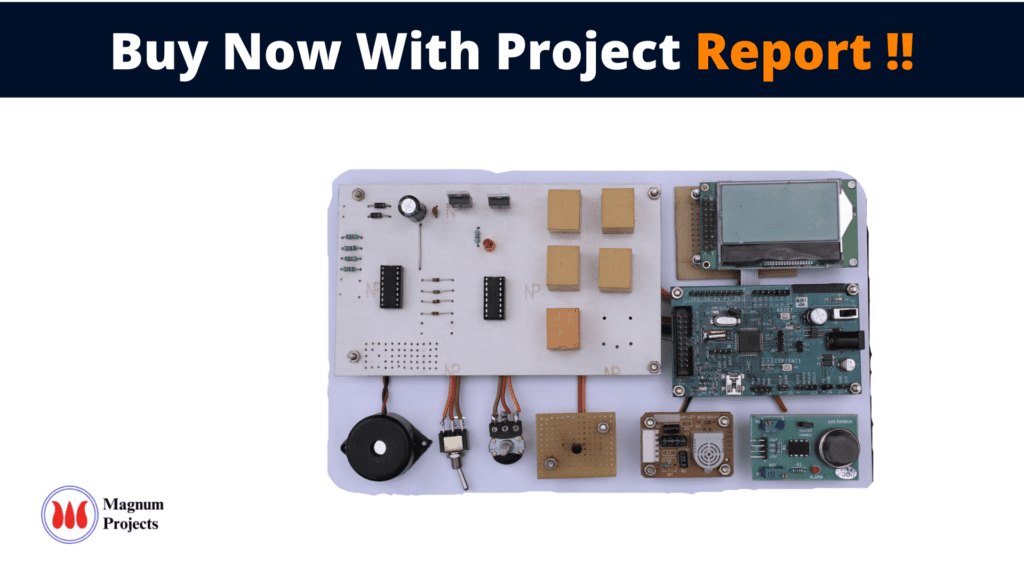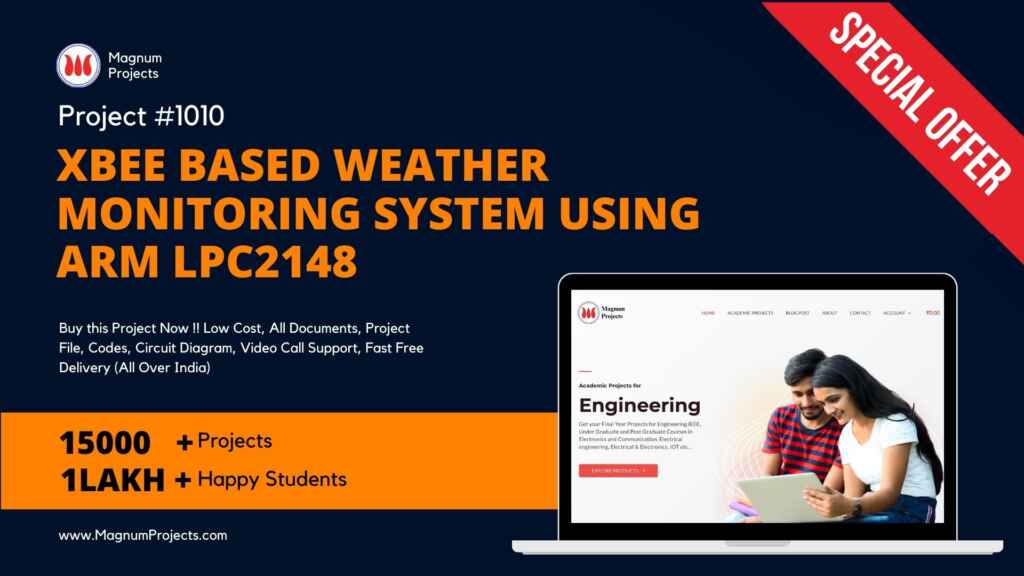Table of Contents
Introduction:


A weather station is a facility, either on land or sea, with instruments and equipment for measuring atmospheric conditions to provide information for weather forecasts and to study the weather and climate. The measurements taken include temperature, pressure, humidity, gas, rainfall detection, and pressure. An automatic weather station (AWS) is an automated version of the traditional weather station, either to save human labor or to enable measurements from remote areas.
Many crop management decisions are based on weather-crop development relationships. Daily weather data is currently used in most crop development research and applied models. Present weather and computer technology now make possible monitoring of crop development on a real-time basis.
Remotely monitoring environmental parameters is important in various applications and industrial processes. In earlier periods weather monitoring systems are generally based on mechanical, electromechanical instruments which suffer from the drawbacks like poor rigidity, the need for human intervention, associated parallax errors, and durability. With the inclusion of electronics, the instruments were made compact and cheaper. However, these systems lack the flexibility of remote monitoring.


Block diagram explanation
Power supply unit
This section needs two voltages viz., +12 V & +5 V, as working voltages. Hence specially designed power supply is constructed to get regulated power supplies.
Temperature Sensor LM 35:
LM35 is a precision IC temperature sensor with its output proportional to the temperature (in oC). The sensor circuitry is sealed and therefore it is not subjected to oxidation and other processes. With LM35, temperature can be measured more accurately than with a thermistor. It also possesses low self-heating and does not cause more than 0.1C temperature rise in still air.
The operating temperature range is from -55°C to 150°C. The output voltage varies by 10mV in response to every oC rise/fall in ambient temperature, i.e., its scale factor is 0.01V/ oC.
Humidity Sensor:
Humidity measurement instruments usually rely on measurements of some other quantity such as temperature, pressure, mass, or a mechanical or electrical change in a substance as moisture is absorbed. By calibration and calculation, these measured quantities can lead to a measurement of humidity. Modern electronic devices use temperature of condensation (the dew point), or changes in electrical capacitance or resistance to measure humidity differences.
Gas sensor:
A gas detector is a device that detects the presence of various gases within an area, usually as part of a safety system. This type of equipment is used to detect a gas leak and interface with a control system so a process can be automatically shut down. A gas detector can also sound an alarm to operators in the area where the leak is occurring, allowing them to leave the area. This type of device is important because many gases can be harmful to organic life, such as humans or animals.
Pressure:
A potentiometer informally a pot, is a three-terminal resistor with a sliding contact that forms an adjustable voltage divider.[1] If only two terminals are used, one end and the wiper, it acts as a variable resistor or rheostat. A potentiometer measuring instrument is essentially a voltage divider used for measuring electric potential (voltage); the component is an implementation of the same principle, hence its name. Potentiometers are commonly used to control electrical devices such as volume controls on audio equipment.
Raindrop detection:
A rain sensor or rain switch is a switching device activated by rainfall. There are two main applications for rain sensors
ARM processor
ARM is a computer processor-based RISC architecture. A RISC-based computer design approach means ARM processors require significantly fewer transistors than typical processors in average computers. This approach reduces costs, heat, and power use. The low power consumption of ARM processors has made them very popular:
The ARM architecture (32-bit) is the most widely used in mobile devices, and the most popular 32-bit one in embedded systems.
Buffers
Buffers do not affect the logical state of a digital signal (i.e. a logic 1 input results in a logic 1 output whereas logic 0 input results in a logic 0 output). Buffers are normally used to provide extra current drive at the output but can also be used to regularize the logic present at an interface
Drivers
This section is used to drive the relay where the output is the complement of input which is applied to the drive but the current will be amplified
Relays
It is an electromagnetic device that is used to drive the load connected across the relay and the o/p of the relay can be connected to the controller or load for further processing.
Buzzer:
A buzzer or beeper is an audio signaling device, which may be mechanical, electromechanical, or piezoelectric. Typical uses of buzzers and beepers include alarm devices, timers, and confirmation of user input such as a mouse click or keystroke.
DC motor:
A DC motor relies on the fact that magnet poles repel and unlike magnetic poles attract each other. A coil of wire with a current running through it generates an electromagnetic field aligned with the center of the coil. By switching the current on or off in a coil its magnetic field can be switched on or off or by switching the direction of the current in the coil the direction of the generated magnetic field can be switched 180°.
Indicator:
This stage provides a visual indication of which relay is actuated and deactivated, by glowing respective LED or Buzzer.
Methodology:
This project is developed to reduce the workload of human beings and to sense the parameters like Gas, Temperature, Humidity, Rain, and Pressure. After sensing that parameter depending on the scenario the ARM controller will take appropriate action. The main modules in this project are Sensors (Temperature Sensor LM 35, Humidity Sensor, Gas Sensor, Rain detection Sensor, and Pressure Sensor), ARM controller unit with LCD and output device.
This whole model can be placed anywhere. This model has five Sensors as an input device to sense the Weather condition and depending on the parameter measured the controller will take appropriate action. This module continuously monitors the weather condition of the place where it is placed. If the temperature varies, Gas is detected, Rainfall is detected, Humidity varies and the Pressure of the weather varies, then the ARM controller will activate the buzzer to convey the information.
Advantages:
- All the components required are easily available.
- It is accurate [Errors are nullified] & precise as it is Digital.
- It is much more economical compared to other analog systems.
- Manual errors can be avoided to some extent.
- Automatically controlled & Easy to use.
- Unnecessary wastage of electricity can be controlled to a greater extent.
Disadvantages:
- In this project usage of relays leads to consuming more power.
Applications:
- This project can be implemented in homes, Schools, Colleges, Companies, etc…
- Where we have to reduce the workload of humans and sense the parameters like Gas, Temperature, Humidity, Rain, and Pressure there we can implement this project.




